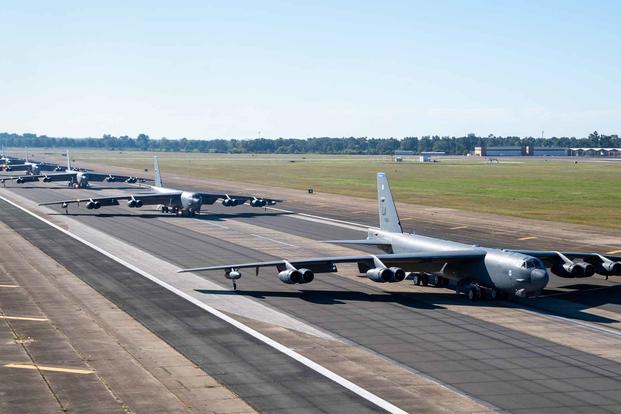With the U.S. Air Force's plan to keep the long-range B-52 Stratofortress flying into the 2050s, the venerable, Cold War-era bomber is going to need new brakes and wheels.
The service selected Collins Aerospace, part of Raytheon Technologies, to design and develop a new wheel and brake for the bomber, and to retrofit 77 new brake and wheel combinations, including spares provisioning, the company said Wednesday.
To increase the brakes' wear life, the company will use its carbon heat sink material known as DURACARB, which provides "increased thermal absorption" as the aircraft slows and brakes on the runway during a landing, explained Matthew Maurer, vice president and general manager of military programs, landing and mechanical systems.
Read Next: It's Official: The Air Force's New F-15EX Fighter Will Be Called the Eagle II
"Today, the aircraft uses the steel brake, and we're going to be replacing that with a carbon brake," Maurer said in an interview Monday.
The new brake-wheel combination "is going to allow for longer intervals between brake overhauls or longer intervals between inspections on the wheels," he added. "We anticipate being through the design and development phase and supporting flight testing by 2023, and then [retrofitting] the fleet by 2026."
Air Force maintainers will work alongside engineers to learn how to change or update the system; Maurer said the service will run the schedule, choosing which bombers will receive the first upgrades. Collins did not publicize the cost of the contract award.
The Air Force already uses the DURACARB system on the C-130 Hercules, F-16 Fighting Falcon and F-15 Eagle. The new wheel is rated for 12,500 miles, a major upgrade from just 1,500 miles for the B-52's current brake system, Maurer said.
The Air Force is also nearing a decision on procuring new B-52 engines.
The service has been pushing for a major engine overhaul for the bomber fleet for years. In 2017, an engine fell off a B-52 while the aircraft was flying over North Dakota. Each aircraft currently has eight Pratt & Whitney TF33-P-3/103 turbofan engines.
Three companies are in the running to replace the engines: Pratt & Whitney, which is a Raytheon Technologies' company; General Electric; and Rolls-Royce. But while the Air Force issued a request for proposal, or RFP, last May, it has delayed issuing a contract award.
In 2019, lawmakers insisted that service officials nail down contract specifics before they would provide funding. That year, the Air Force estimated it would spend around $1.3 billion through 2024 on work related to the re-engining.
The RFP stipulated a total of 608 engines for its 76-aircraft fleet.
While officials have said there has been no delay, the service has still not committed to an official award date.
Gen. Tim Ray, head of Air Force Global Strike Command, said in February that it's "too early" to determine whether the award will be announced in June -- the original projected contract announcement time frame.
"We should have this summer the answers back from the competitors to be considered," Ray said during the Air Force Association's virtual Aerospace Warfare Symposium. "And so then, from that process, we'll go from there.
"This is not being [dragged] out," he said, as reported by Defense News. "It is on time. In fact, it is several years early."
He said that digital prototyping, or simulating parts via computer models, has begun on the companies' side, which could shorten the engine production time.
The planes are among the oldest in the Air Force. Three generations of airmen have flown the B-52 in combat, from Vietnam to Afghanistan; the final bomber rolled off the production line in 1962.
The B-52 has been prominent in missions such as Operations Desert Storm and Iraqi Freedom, as well as the fight against the Islamic State in Iraq and Syria.
Affectionately known as Big Ugly Fat Fellow, or BUFF, B-52s have been on rotation for the service's Bomber Task Force, or BTF, missions over the past year, part of the Pentagon's larger "dynamic force employment" strategy. As part of the BTFs, the service sends out two to four bombers for units to test how nimbly they can move from place to place.
-- Oriana Pawlyk can be reached at oriana.pawlyk@military.com. Follow her on Twitter at @Oriana0214.
Related: The Next B-52 Bomb Upgrade May Be a Tough Message for China












